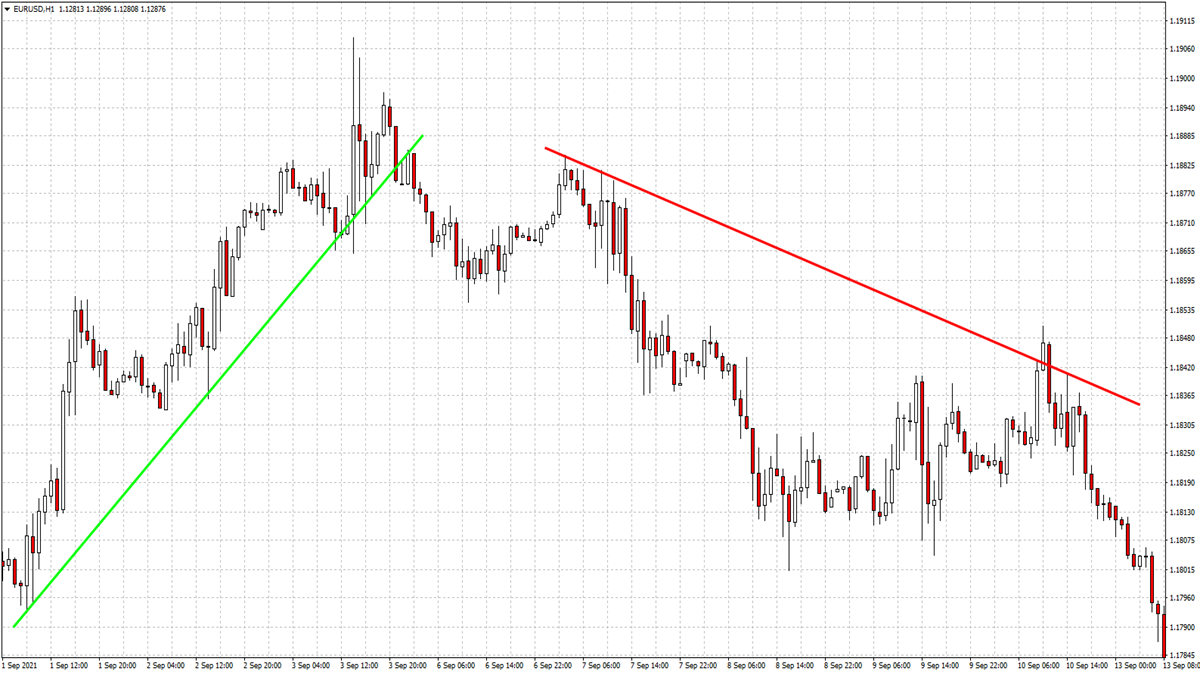- Education
- Forex Technical Analysis
- Basic Concepts
- Forex Trend
Forex Trend: Trend Lines in Technical Analysis
Trend Lines in Technical Analysis
Trendlines are a very useful technical analysis tool; they help visualize the trend and identify potential reversal points. A trend line is a straight line that connects two or more price points and extends into the future (acts as a support or resistance line, so it’s better to learn it first).
Trendlines give traders a pretty good idea of where price is heading. With trend lines traders are able not only see the trend of the price, but its speed as well as the price patterns during periods of time.
In this article, we will help you understand what trendlines are and how to recognize and use them.
Let’s dive in.
KEY TAKEAWAYS
- Trendlines are commonly used by traders looking to make sure that the underlying trend of an asset is working in favor of their position.
- It takes at least two highs or lows to draw a valid trend line but it takes three to confirm a trend line.
- Trendlines can also experience a failed breakout pattern.
- Longer term trend lines prevail over shorter term ones.
What is a Trendline
As we mentioned, the trend line is an important tool used in technical analysis. With these lines analysts are able to look for price trends, determine the direction price is heading. It is believed that trend lines are traders best friends, we do not disagree.
So what is trend line?
To be able to draw a trend line traders will need at least two price points. Traders might use one or five minutes time frames, or daily charts. But some use a different approach - viewing trends based on minimum upward or downward movement in the price.
A trend line is a straight line that connects several points on a chart, which can be used to both establish trends, and to forecast the future direction of a given asset, the trend lines show zones where the forces of supply and demand meet and push prices to move.
A support level is a level where the demand for an asset is stronger than the selling pressure, preventing prices from falling further. And vice versa, a resistance level is a threshold at which selling pressure is greater than buying pressure.
Check out the graph with drawn lines:

The uptrend line has a positive slope and to draw a trend line trader will need to draw an ascending line by connecting at least two low points, furthermore the second price point has to be higher than the previous one.
Note: The more low points involved in the uptrend line construction, the more accurate trend line will be.
The uptrend lines act as a support, meaning net-demand is increasing even as the price rises. A rising price combined with increasing demand is an indication of strong bullish tendency; a strong demand on buyers' part. The uptrend is considered solid when prices stay above the trend line, when prices cross the trend line it is the sign of a trend line weakening, and there might be change in the trend direction.
The downtrend line has a negative slope and to draw a trend line trader will need to draw a descending line by connecting at least two high points, where the second price point has to be lower than the previous one. The same rule with the number of connected points applies to the quality of the downtrend line.
The downtrend line acts as a resistance, meaning net-supply is increasing even as the price declines. A declining price combined with increasing supply is an indication of strong bearish tendency and it shows a strong position on sellers' part. The downtrend is considered solid when the prices stay below the downtrend line, and in case prices cross the line it signals the trend is weakening. Which might be an indication of trend direction change.
Types of Trend Lines
Before talking about trendline types, we would like you to remember this simple rules:
- It takes at least two highs or lows to draw a valid trend line but it takes three to confirm a trend line.
- The sharper the trend line you draw, the less reliable it is going to be and the more likely it will break.
- Trend lines become stronger the more times they are tested.
- Never try to force a trendline to fit the market - if it doesn't fit it means the trend line is not valid.
Here we go, the 3 types of trend lines:
- Uptrend - An uptrend line suggests the emergence of higher lows from the price movement, the second low and other lows are always higher than the previous one. It is always drawn and is below the price action. This line is a kind of support line, but with an upward bias. To draw an uptrend line, you need to link well-recognized lows or support areas. Just find the two main bases and connect them with a line. So you have an uptrend line!
- Downtrend - A downtrend line suggests the appearing of lower highs from price movement, the second high always lower, than the first one. It always draws and stands above the price action. This line is some kind of resistance line, but with a downward slope. To draw a downtrend line you need to link well-recognizable highs or resistance areas. Just find two major tops and connect them with a line. Here you have a downward trend line!
- Sideways trend - This is a bit specific price action, because trend suggests some acceleration to upside or downside, but particularly this feature is absent in sideways move. Usually this kind of price action is called “Ranging”. Building a trend line gives the lines a very similar look to support and resistance, because the difference between highs and lows is very shallow. But they are not the same – to build a support or resistance area you need just one point. For any trend line you need two points.
Trend lines in Forex
As you can imagine trade lines can be used in Forex markets as well and everything mentioned above is applicable for the trendlines in FX.
We're going to list a few rules and want you to learn it by heart, you will need them, here they are:
- Trend lines is not a particular number, but some area around it
- If the market has closed below or above uptrend or downtrend and holds there at least for 3 periods, then, possibly this line is broken.
- Trendlines can also experience a failed breakout pattern.
- The market may slightly break the trendlines, and if it did not close below them, then the trendline may still be valid.
- After a breakout, the market can retest the broken trend line from the other side. Some call it “Kiss goodbye”.
- The longer the trendline is formed, the stronger the movement can be after the breakout of that trendline.
- Trend lines and support/resistance lines are not the same. To estimate support/resistance level will be sufficient even one point. To draw a trend line you need at least two points for determination of slope angle.
- Longer term trend lines prevail over shorter term ones. This means that if at some point the trend lines meet in the opposite direction, then the likelihood that the longer-term line will break the short-term one is higher.
There is no rule about the strength of the trend line as there is for support/resistance lines, because the trend line has a slope and its level changes during the trading period. There is also an opinion that the trend line is getting stronger, but this is difficult to prove. Because on the one hand, the more obvious the trend line, the more traders open positions in the direction of this trend when the market touches it, which means they add support to this line.
But on the other hand, more and more trailing stops are accumulating below this trend line. As this becomes more and more evident, the more market makers are tempted to press the trendline a little and trigger those stop orders.
Bottom line on Trend lines in Technical Analysis
Trendlines are commonly used by traders looking to make sure that the underlying trend of an asset is working in favor of their position. Trend lines offer a great insight and though they are very useful, they are merely one tool that helps to establish, analyze, and confirm a trend. Remember, basing technical analysis solely on trend lines is a mistake.
Traders should take trendlines insights as a warning that the change in trend may be inevitable. So paying close attention to line breaks is a must do and then try to use other confirming signals for potential change in the trend.
While many traders will argue about which prices to use when plotting a trendline, remember that everyone will agree that the strength of a trendline increases as more prices test support and resistance.

Not sure about your Forex skills level?
Take a Test and We Will Help You With The Rest
How to use Forex Trend in trading platform
You can see the graphical object on the price chart by downloading one of the trading terminals offered by IFC Markets.


